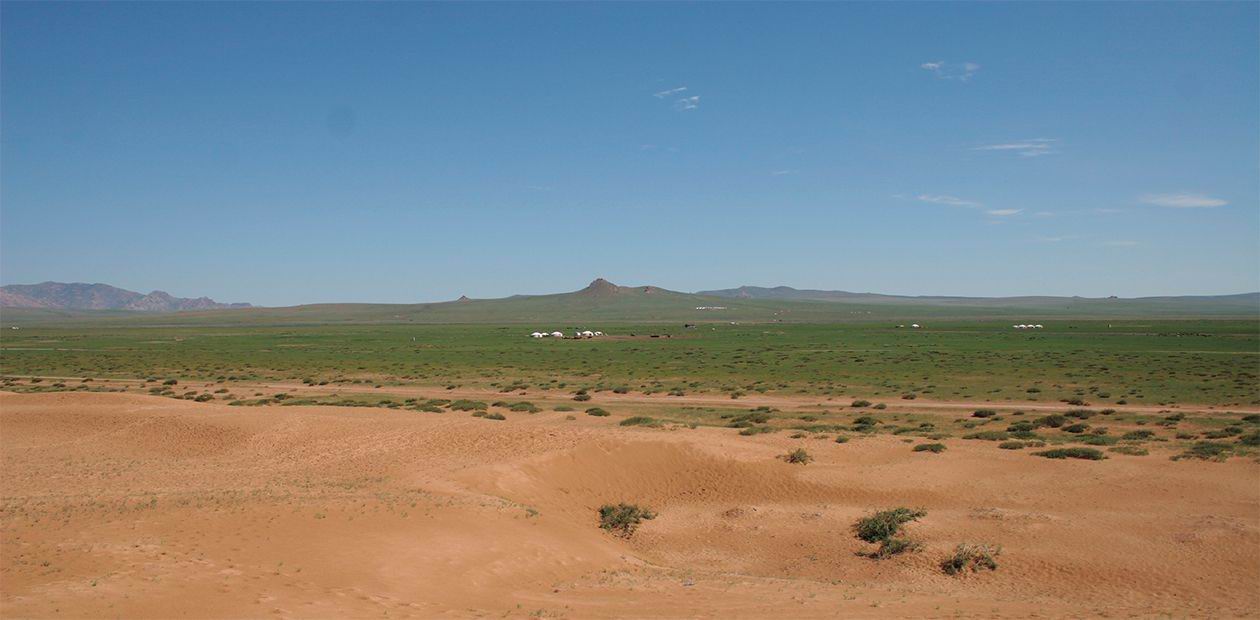A Nomad in the Epoch of Globalization
At the beginning of the third millennium, the tendency towards accelerated development so characteristic of China and neighboring states of Central and South-East Asia became more pronounced. Despite some pessimistic prognoses, Asia is undergoing such an upswing that a shift of world business centers can be observed from the Atlantic to the Pacific. The current situation ncourages development of national ideas; from this point of view, social-economic and political processes occurring in Inner Asia, especially in the world of Mongol peoples, are of special interest
Through the millennia, the Mongolic peoples formed their historical and cultural space whose basis was nomadic cattle breeding. Over a long period in history, numerous state-like formations were created that made part of the Russian and Tsin Empires in the 17th—18th centuries. Outer Mongolia, which became autonomous in 1911, was transformed first into the People’s Republic of Mongolia and then into the Republic of Mongolia.
By the beginning of the 20th c., Mongol peoples lived within the territories of the three Socialist states — China, Mongolia and the Soviet Union. As a result of a drastic change in their politics, the Soviet Union and Mongolia switched to market economy whilst China carried out a number of radical reforms in economics without overthrowing the Socialist regime.
In order to study the situation with modern Mongol nomads and to observe current transformation of nomadic communities, a few comprehensive joint expeditions were organized by research institutes of Russia, Mongolia, and China. These expeditions resulted in a variety of data concerning the way of life, methods of economy, social organization and culture of the Mongol peoples, Tibetans of North India, and Dagurs and Barguts of China.
Life after perestroika
Investigations performed have shown that Mongolic peoples of Inner Asia (also known as Central Asia, or Middle Asia) are experiencing socio-economic and demographic problems common to transition communities, such as economic decline and the necessity to develop economics and culture.
The core of the socialist regime was state property and authoritarian relations. Today, both Mongolia and Russia are undergoing dramatic change: the relation to property is becoming an important element of the social structure. Distinguishing features of the new society are high polarization of incomes and a tough social and property hierarchy.
Similar processes are taking place in Buryatia but, in comparison to Mongolia, middle class is being formed more slowly.
By the way, Russia and Mongolia are both making efforts to revise the politics of forced liberalization, which has demonstrated its inconsistency with indigenous values.
Among the problems associated with the change of the economic system is the so-called spiritual vacuum caused by the downfall of the communist idea, which has brought about more social problems. Mongolia and Russia are facing negative consequences of long-standing negligence of social and cultural factors. For instance, unwillingness of a large part of the population to adopt market relations, lack of enterprise and business initiatives, which have many years been punishable, are attributable to the conservative structure of demands, rupture of relations between generations, and loss of some socio-psychic traditions.
The first steps towards reviving the social and cultural memory of Mongolic peoples living in these two countries were resumed, at the state level, by observances of traditional festivals and customs. And what is the situation with the nomadic communities of our great southern neighbor who has chosen a different route of political, social and economic reforms?
Mongolian China
Since the 1980s, China has rejected totalitarian economy and demonstrated amazing economic growth. The reasons behind this phenomenon are, first, the specific development concept aimed at leveling the growth rates of the center and provinces; second, the policy of open society; and third, a new approach to the national problem.
Having declared the principle of “open politics”, the country’s leaders focused on fundamental interests of the nation, but were confronted with a complicated problem: out of the total 180 major transit points of foreign trade, 120 were located in national autonomies. Evading the ticklish dialogue with national minorities, China adopted a completely new national policy without unnecessary proclamations.
In this way, new life was breathed into Inner Mongolia. Thanks to modernization programs, gross domestic product (GDP) of this autonomous region was 271 billion Yuan in 2004, which was a 20 % growth on the year-to-year basis, more than twice higher than the national average and 13-fold higher than the GDP in the pre-reform 1978.
The leading branch of the region’s economy is agriculture. Grain production has been growing; cattle-breeding has been efficiently restructured and now yields 40 % of the total agricultural output. In late 2004, there were 92 million head of cattle (which is several-fold higher than the average number for Russia), which was 16 % more than in the previous year. Transport, trade, food production, furniture production, service, and tourism have demonstrated an impressive growth.
Over 25 % of GDP is made by the private sector, which brings a handsome portion of taxes. Rapid development of private economy goes hand in hand with improvement of its structure. While in the not too far away past individual entrepreneurs were mainly engaged in trade and service, nowadays the range of their activities has expanded to include processing of agricultural products, transport, power industry, construction, etc.
Goats “have eaten” people?
Despite the indisputable success of Inner Mongolia’s economy, a great many problems, including social ones, remain to be solved. First of all, this is the need to increase incomes of cattle-breeders and crop-growers. Another pressing issue is rapid development of services sector which is necessitated by overloaded infrastructure of the cities due to active migration.
Considerable increase in the cattlehead has made cattle-breeding very important both for the countries’ economies and for everyday life. However, failure to draw on the many-century experience of interaction between nature and human society can have harmful repercussions. Scientists have testified that a lot of lands are turning into deserts — the environmental situation is complicated and, in some places, threatening. In addition to objective reasons, this alarming situation is caused by higher prices on cashmere, goat’s down, which resulted in a sharp increase in the number of goats in the Gobi desert, Inner Mongolia.
To compare: the territory of Inner Mongolia is 500,000 km2 smaller than the territory of the Republic of Mongolia whilst the population of Inner Mongolia is ten times greater and the number of cattle heads is three times larger than in the Republic of Mongolia. Today, this “stock” of 90 million heads poses a serious threat for half-desert pastures. Goats have smaller teeth and sharper hooves than sheep, for example, and they are not hard to please as far as food is concerned. A stock of goats grazing on hill slopes leaves these slopes bare — the plants’ fragile roots are stripped, which results in large masses of sand rolling down.
Our first conclusion is as simple as that: Goats have eaten people. A more detailed study of this problem, however, revealed another issue related to the social factor: namely, allotting land to peasants.
In Inner Mongolia, this process had some specific features. A land plot was let first for five and later for ten years. Cattle-breeders have thus accumulated a lot of land, which they used without considering the consequences. Even extending the term of the rent to 20 years could not alter the peasants’ inertial thinking. Besides, increase in the population made competition for pastures tougher. These processes took place in the vast area of North East Asia and part of Central Asia and resulted in soil erosion, sand hurricanes and forced migration of population to other regions.
In all probability, a large number of Geat deserts are the nature’s revenge for man’s ruthless interference in natural processes. This is why it is so important today to remember about the optimal balance between nature and society as well as to draw on the experience of cattle-breeding in the Great Steppe that has been tested during millennia.
As for the Republic of Mongolia, one additional fact can be given to support the justness of ancient laws of using nature and the way these laws work when we return to the old forms of nomadic cattle-breeding: namely, growing migration of agricultural population to cities. The point is that the number of people and cattle that steppe landscapes can support is limited – soil can bear only a certain level of anthropogenic burden. This is why the total head of cattle in Mongolia is always the same: 30 million. The “redundant” population gathers in the few cities of the republic, setting up yurt settlements at their outskirts.
These processes have encouraged the growth of socially unstable groups of the population and boosted emigration. For the time being, 130 million have emigrated, which is a large number for a country with a total population of 2.8 million. Primarily, these processes concern young people: this is why in cities the number of people prone to crime is increasing. This brings to mind the historic situation that led to the establishment of the famous military nomadic empires, which have left a pronounced trace in the history of many eastern and western civilizations*.
When we go back to traditional nomadic economy, we should thus bear in mind that the balance between nature and society regulates, in the natural way, not only cattle head but also human population. A result of this process is the outflow of able-bodied population to cities and beyond the Great Steppe. As soon as extensive economy exhausts itself, rapid development of the private sector might aggravate the situation. At the same time, it is possible that time will come when the form of private property that will become land property will no longer meet the requirements of nomadic economy as a way of production.
We would like to draw your attention to another important issue. Globalization pursued by developed countries does not take into account the variety of human communities, especially of East-Asian countries. Striving for profit and super-profit prevails over human rights, tradition and values formed during millennia, which is much more dangerous than the destruction of soil.
The value of each nation, ethnos and person,relies on their “historical tree”, its deep roots and its beautiful cultural crown. The experience of East Asia has shown that interaction, rather than destruction, of these traditional and historical values can bring rich fruit both on the national and global scale.
*SCIENCE First Hand journal, № 1(13), 2007.











